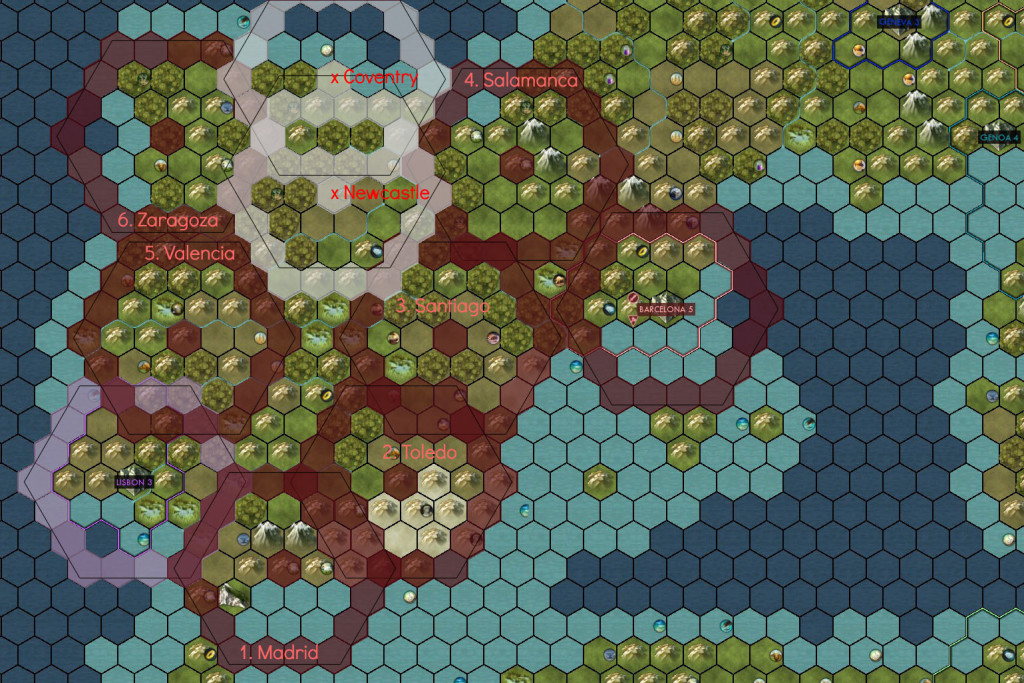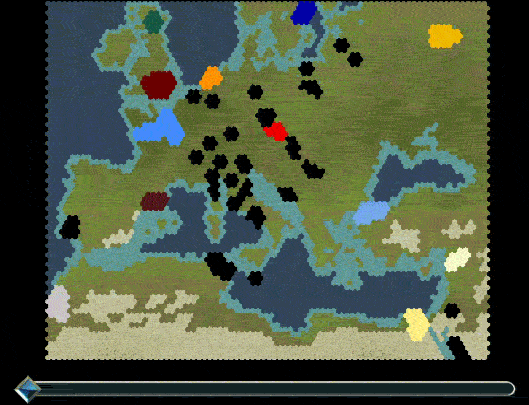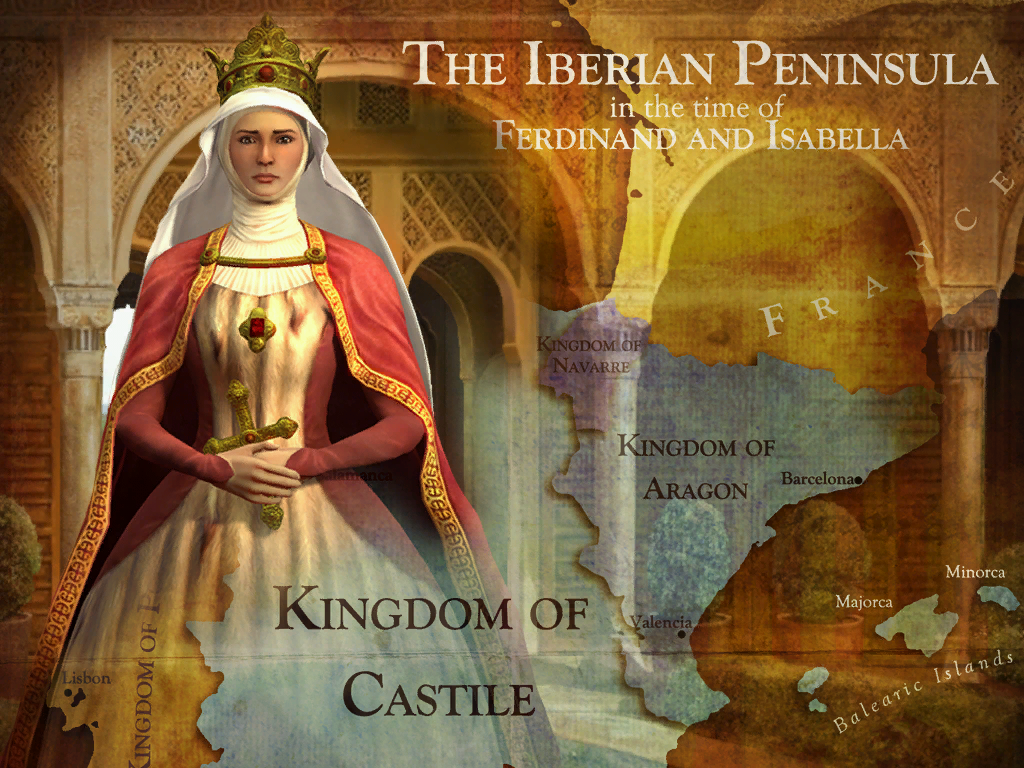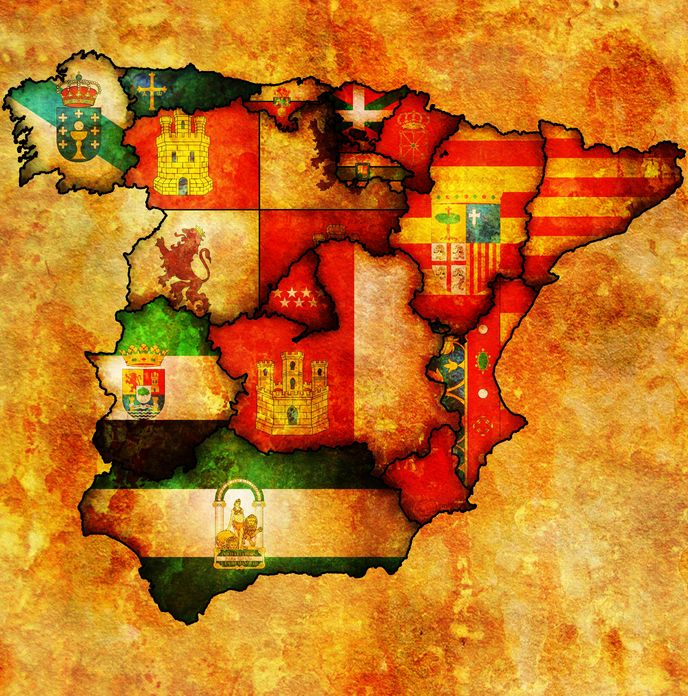Spains way into the Renaissance was a long and challenging one. By the end of the 10th century, muladíes – Muslims of ethnic Iberian origin) had been the biggest group among the population of the Iberian Peninsula. In the 11th century the Muslim realm fractured into smaller independent kingdoms. This allowed the formerly small Christian kingdoms to enlarge their domains and increase their power.
 You’ll start not exactly, but a little bit after the beginning of the Reconquista, the centuries-long reconquest of Muslim Iberia by Christian kingdoms. The actual reconquest lasted centuries, with the frontier between Christian and Muslim kingdoms fluctuating hugely.
You’ll start not exactly, but a little bit after the beginning of the Reconquista, the centuries-long reconquest of Muslim Iberia by Christian kingdoms. The actual reconquest lasted centuries, with the frontier between Christian and Muslim kingdoms fluctuating hugely.
Only when the strategically important city of Toledo was captured in 1085, the balance of power shifted in favor of the Christian kingdoms. This is where this scenario starts. You’re playing as Isabella I of Castille, who only came to power towards the end of that period.
By then Christendom had pushed back the Muslim kingdoms on Iberia, with the biggest strongholds falling in the 13th century (Córdoba and Seville) leaving only Granada under Muslim rule.
Only in 1469 Spain got formed as one nation through the marriage of Isabella I of Castile and Ferdinand II of Aragon. The way into the renaissance led to the unification of Spain, laid the foundation for the numerous expeditions started by Spanish explorers and merchants and thus paved the way for Spain to become the first world power. Let’s follow in their huge footsteps! 🙂
Into the Renaissance – Spain Strategy (Deity)
Prologue: Spains Unique Traits & Happiness
The Spanish trait “Seven Cities of Gold” allows you to send Conquistadores to the western end of the map to receive 500 Gold and 250 Victory Points. You can do this four times, so to a maximum of 1.000 VP!
| Tercio | Conquistador |
|---|---|
| The Spanis Tercio replaces the Musketman and has not only a higher combat strength (26 vs 24) but also comes with a +50% bonus vs Mounted units, so it’s much better suited to withstand cavalry.
Historically these units were the first adoption of combined arms. Mixing pikes and firearms in a single unit, the Spanish Tercio were the finest infantry in Europe throughout the Renaissance. |
The second Spanish unique unit is the Conquistador, which replaces the Knight. It can embark with defense and has +2 Extra Sight, making it an exceptional scout for your ranged units bombarding enemy cities. |
Altogether the Spanish unique traits are really nice. They’re all purely military though, so none of them really affect much of the overall strategy. You might very well win the game without either of those, as they’re no game changers.
Part 1: Settle as much of Iberia as possible
Chapter 1: Settling Spain – Establishing your Empire
Playing Into the Renaissance Spain is even harder than France. Check out the Into the Renaissance map first. France at least has the north coast blocked and many city states in the east. So once you close the Pyrenees and the Atlantic coast, you’re safe. For Spain that’s so much harder: Your main enemy will be the Almohads and you have to deny them Iberia completely. Then block the west coast of the Iberian peninsula.

As you can see above, the English have sneaked in 2 of their cities. In my entire game I have not been at war with them, but having theses cities there, was painful to see.
Above are my initial city positions for Spain. As you can see from the order:
- Primary goal is to block the coast so the Almohads don’t settle there. They came via Lisbon though and I had to declare war early.
- Secondary goal is to prevent France from settling south of the Pyrenees. Salamanca will block the passes, but they’ll come via the ocean. Capture their settlers even though this means war.
- Last block the west coast as efficiently as possible, claiming most good land while not allowing tiles to settle on the coast.
Chapter 2: Initial Build Order and Social Policies
The above settling strategy wouldn’t work without immediately going for Liberty, the free settler and the ability to build more settlers faster. Anything after that is a must, due to your unhappiness from the rapid expansion.
- Liberty
- Republic – +production in cities
- Collective Rule – for a free settler plus bonus on producing settlers
- Citizenship – (turn 5) for a free worker and faster improvements
- Tradition – (turn 22) for more culture in your capital
- Legalism – (turn 37) for 4 free culture buildings in your first cities
- Meritocracy – (turn 45) +1 Happiness for each city connected to the Capital
- Honor – (turn 55)
- Warrior Code – (turn 66) for an early General +production bonus on melee units
- Military Tradition – (turn 77) for +50% XP for all units, which you need early to grow a huge number of veterans.
- Discipline – (turn 88) +15% bonus for melees flanking each other
- Military Caste – Happiness and Culture from city garrisons
- Professional Army – (turn 111) Happiness from defense structures and decreased upgrade costs
- Commerce – (turn 122) +25% GPT in the capital
- Trade Unions – (turn 135) 33% less maintenance costs for roads
- Mercantilism – (turn 150)
- Order – (turn 150)
Only with Meritocracy in turn 45 my happiness rating was positive again, allowing me to grow cities at the normal rate. The build order includes many many workers to quickly improve the land, again giving priority to luxury resources for happiness:
| Barcelona | Madrid (turn 5) |
Toledo (turn 15) |
Santiago (turn 29) |
Salamanca (turn 41) |
Valencia (turn 53) |
|---|---|---|---|---|---|
| 1. Settler (Toledo) | 1. Worker | — | — | — | — |
| 2. Lighthouse | 2. Catapult | — | — | — | — |
| 3. Work Boat (2x) | — | 1. Worker | — | — | — |
| 4. Settler (Santiago) | 3. Worker | 2. Market | — | — | — |
| 5. Colosseum | 4. Work Boat | 3. Composite Bowman | 1. Worker | — | — |
| 6. Settler (Salamanca) | 5. Walls | 4. Colosseum | 2. Composite Bowman | — | — |
| 7. Work Boat (2x) | 6. Stable | — | — | — | — |
| 8. Library | — | — | 3. Colosseum | 1. Worker | — |
| 9. Settler (Valencia) | 7. Market | 5. Library | — | — | — |
| 10. Composite Bowman | — | 6. Composite Bowman | 4. Market | 2. Walls | 1. Watermill |
| 11. Settler (Zaragoza) | 8. Circus | 7. Composite Bowman | — | 3. Colosseum | — |
| 12. Temple | 9. Colosseum | 8. Temple | 5. Library | — | 2. Market |
| 13. Aqueduct | 10. Library | 9. Barracks | 6. Walls | 4. Market | 3. Colosseum |
| 14. Composite Bowman (2x) | 11. Temple | 10. Composite Bowman | 7. Composite Bowman | 5. Amphitheater | 4. Amphitheater |
| 15. Workshop | 12. Workshop | 11. Workshop | 8. Workshop | 6. Workshop | 5. Workshop |
| 16. Ironworks | 9. Barracks | Units | 9. Barracks | … | … |
| 17. National College | Units | Units | Units | … | … |
| 18. University of Oxford (finished turn 123) | Units | Units | Units | … | … |
Infrastructure and Movements
Have your workers immediately start building a road from Barcelona to Madrid. Build it in a way you pass by Toledo and Santiago, so you can found these cities quicker. At Madrid, build some more roads towards Lisbon. It’ll ally with the Almohads sooner or later and again you need to be able to maneuver and shoot, so roads are vital!
Research
Although in the end it’s not decisive for the game, I like to at least try to score some Exploration VP with the seafaring nations of Western Europe. The research path reflects that, as I try to get Exploration as soon as possible:
- Civil Service (turn 43)
- Guilds (turn 59)
- Theology (turn 69)
- Metal Casting (turn 78 for Workshops)
- Education (turn 92 – build Universities!)
Research Agreement with William signed turn 102! - Machinery (turn 104)
- Compass (turn 111)
- Astronomy (turn 121!!!)
- Exploration (turn 123!)
Research Agreement with William and Austria in turn 128! - Navigation (turn 141)
- Chivalry (turn 147)
- Metallurgy (turn 152)
Austria denounced me before the Research Agreement could be fulfilled 🙁 - Banking (turn 157)
- Steel (turn 161, compared to 113 in my France game)
- Humanism (stolen turn 170)
- Printing Press (turn 179)
I had to declare war on France in turn 47 as to now allow them a settlement on my side of the Pyrenees. This war lasted centuries as in the beginning they didn’t want peace, while later, after the tides of battle had turned, I didn’t want peace! Just look at their initial peace offer: Ridiculous! I got my first spy in turn 66 and send him to Amsterdam. In the entire game I hadn’t been at war with the Netherlands at all.
Chapter 3: Consolidate your Kingdom
Meanwhile Morocco had declared war on me, too. Or I did, when I encountered one of their settlers sneaking through Lisbon into my land. At this point in time, that’s not a bad thing, as they won’t send many units against you. Dealing with France and Morocco was quite alright.
Then I had to reload some turns before, because with what happened, I could have never won this game: In turn 73 both England (2 cities in Spain already) and the Ayyubids declared war on me. Lisbon was an ally of the Ayyubids and threatened to capture one of my cities!!!
Going back some turns I was able to build some more units. Also I had built a citadel towards Lisbon, helping to defeat their massive army (compared to mine). Furthermore I bribed the Ayyubids against England.
To build a Citadel on Lisbon territory, move your Great General into their land and leave him their for one turn (which will earn you a reputation penalty). Once he can move again, declare war, build the Citadel and make peace again.
As I literally bribed the Ayyubids with everything I had, including one Luxury resource I only had once, I declared war on them right after bribing them against England. At least it successfully prevented England from ever going to war with me.
Following the above build order I already had a catapult in Madrid plus 9 Composite Bowmen. Also you can use some Faith to buy a pikeman or other melee. That’s enough to defend the Pyrenees against France (4 archers), defend Valencia against Lisbon (5) and be flexible enough to send some units South should the Almohads come for you. Around turn 100 Spain was going Into the Renaissance with big steps, standing strongly on Iberia. In turn 102 I even made peace with the Ayyubids for 3400 Gold (for me).
Part 2: Spain becoming a Naval Power!
Chapter 4: Exploration
First of all: You have to excellently time building the University of Oxford (granting you a free technology) and your own research of Astronomy. Make sure you have Astronomy 1 turn before Oxford finishes, so you can get Exploration for free.
Beware: Caravels can not be bought at this time. You have to build them, so optimize your cities for production and try your best! Here’s how it worked for me:
- Zaragoza started a Caravel turn 123
- Madrid started a Caravel turn 123
- Barcelona started a Caravel turn 126
- England scores 500 VP for Exploration #1 in turn 129
- Barcelona finishes a Caravel in turn 133, which is destroyed by the Almohads
- Zaragoza finishes a Caravel in turn 134
- Madrid finishes a Caravel in turn 134
- Spain scores 400 VP and 300 VP for Exploration #2 and #3 in turn 134
- Almohads score 200 VP for Exploration #4 in turn 139
- Zaragoza finishes a second Caravel in turn 144
- Spain scores 100 VP for Exploration #5 turn 144
In the end I got 800 of 1500 available Exploration VP, which is quite alright. Playing England on Deity I had managed only 700, but with the Celts it was the full 1500 VP.
Interlude: Spain and Religion
Playing Into the Renaissance as Spain there’s not many other civilizations to turn against for scoring VP. My initial plan was simply to convert to Islam and conquer Catholic Europe. It was the obvious thing to do whilst already being at war with France.
So first I had Catholicism in all my cities and purchased Cathedrals with Faith. Cathedrals are great for Faith, Culture and Happiness. Also you can have an artist work there, if your cities must not grow anymore. Later I spread Islam in all my cities. And I repeat: In all my cities. Nonetheless my state religion didn’t change anymore. Maybe this can only happen earlier in the game…
In the end it wasn’t too bad: I could buy Mosques with Faith in all former Catholic cities, again enhancing Faith and Culture yield. Eventually I let the Catholic pressure “reconquer” Spain and ended up with cities being Christian again.
During my conversion to Islam the Celts had send dozens of Missionaries. To kill them I declared war on them some time in the 150s. In turn 166 a peace treaty earned me 1700 Gold!!!
Chapter 5: Mare Nostrum
In the 130s an Almohad fleet started gathering near Barcelona. To keep them busy I bribed the Turks to declare war against the Almohads. This successfully bought me some more time. Around that time I captured Lisbon and completed my conquest on Iberia in this game.
Starting in the 140s you’ll have to defend your coastal cities Madrid and Barcelona from enemy navies anyways. Place some rookie and some veteran Crossbowman strategically and that should work fine. Don’t kill enemy ships with your ranged units though! Build Privateers and capture as many as you can.
- 144 – Lisbon, 17 population = 425 VP
- 152 – Aberystwyth, 4 population = 100 VP
- 159 – Poitiers, 15 population = 375 VP
To secure my coastline and enlarge with control of the Mediterranean Sea, the Balearic islands had to be the first step. Around that time military supply became an issue. I didn’t want to keep too many unproductive cities, but still wanted to engulf those islands. A new city had to be founded.
Dijon and Grenoble (from France) for now completed my conquest of Islands in the Mediterranean. Both cities granted no VP, as they were Catholic at the time.
Part 3: Conquest of France and Northern Africa
Here’s the short version and the victory points I scored. The following “chapters” are a mere slideshow of the conquests, as tactics have been explained in various other Into the Renaissance blog posts.
- 165 – Rouen, 16 population
- 170 – Avignon, 15 population
- 17x – Chartres, 14 population, conveyed to me by Peace treaty
- 175 – Tunis, 20 population = 500 VP
- 178 – Valetta, 18 population = 450 VP
- 178 – Valetta, 9 population = 225 VP
- 182 – Dornbirn, 16 population = 400 VP
- 184 – Kabis, 12 population = 300 VP
- 185 – Bidzala, 24 population = 600 VP (!!!)
- 191 – Murcia, 20 population = 500 VP
- 194 – Cordoba, 18 population = 450 VP
- 195 – Nancy, 6 population = 150 VP
- 195 – Sijilmasa, 20 population = 500 VP
- 196 – Kursk, 14 population = 350 VP
- 198 – Kursk, 3 population = 75 VP
- 198 – Sijilmasa, 5 population = 125 VP
- Overall 4625 VP by conquest in this late phase of the game.
Chapter 6: France
With various veterans of the Pyrenees being at war for hundreds of years, capturing French cities was only a matter of time. Elite Trebuchets and Crossbowmen fought back incoming French units and spare bombardments were directed at the cities of Rouen and Avignon. Unfortunately they were Catholic, thus granting no VP. Chartres was assigned to me in the following peace treaty. Although France amassed units at the border, this was end of the Spanish-French war in this game.
I did not have to fear any other European power, as they’ve had enough internal quarrels: In turn 171 both Sweden and the Netherlands declared war on Austria, keeping them busy at land.
Chapter 7: The African Coast
In turn 161 I could make peace with the Almohads. This bought some time to finish France in the Mediterranean and capture Tunis and Valetta. I wanted Valetta as small as possible as quickly as possible, because it was likely to fall, quickly again. It was directly in the way of any Turkish fleet sailing west. So I captured it for 450 VP, sold it to Byzantium, declared war on Byzantium and captured it again for 225 VP (because population size was only half).
After that my reputation with almost any other civilization was at an all-time low. While being at war with the Almohads again from turn 181, Turkey had also denounced me. Even before the Valetta “incident”. Right after, Sweden, the Netherlands and the Ayyubids denounced and mocked me.
Only a few turns after Byzantium made peace with it’s arch-enemies the Turks and the Ayyubids, the Turks turned on me and declared war in turn 189.
From then on diplomacy didn’t matter anymore. The rest was conquering every Almohad coastal city in Northern Africa. Starting from Tunis in the east and slowly advancing west. It’s important to as early as possible control the Strait of Gibraltar, so less Almohad ships can threaten you in the Mediterranean. Place your defending ship so only 1 enemy ship can attack per turn.
Once you control the sea completely – ship some units over, veterans and rookies. You’ll need them to stand against the waves of Almohad counter attacks. Sometimes you might even let them get a city – recapturing gives VP and the city size decreases faster.
Chapter 8: Winning the Game
In the end, I was 2nd in Land size and scored a normalized 12539 points, giving me an Augustus Caesar rating. The scenario score of 8276 is not the highest I had achieved, but still it’s been a great Deity game.
Into the Renaissance Spain (Deity) – Conclusion

Spain was (or will have been) the 3rd last game of the Into the Renaissance Scenario. It wasn’t an easy game, as Spain is surrounded by enemies.
With converting to another religion being highly unlikely (Spain is Catholic even today after all), there’s only one opponent to turn to.
One might think of not messing with France so much, but you also can’t let them take away your land… So the way is predetermined: Don’t allow the Almohads to settle in Iberia, finish the reconquista and go beyond it: Make Northern Africa yours!
All this is possible, even on Deity difficulty. Not only that: You can also make Spain the main exploring nation in the Age of Discoveries! You can re-play Spains history!






















































I’m very late and I don’t think anyone can help with my questions, but I can hope. I found this site with what appears to be excellent information and strats, however religion is never once mentioned. Hence my question(s) is this scenario not religious themed? I’ve tried Spain and Russia and within 20 turns I’m bombarded by missionary’s changing my cities religion, is there anything to stop this or defend against it? I suspect it has to do with monasteries, but those need wine or incense….right?
Hi Chuck, there’s always hope!
There is a small section on Religion in the general Into the Renaissance Scenario Strategy Guide. But it’s not extensive. In your example of being overrun with Missionaries: What civ did they come from?
At the start Spain is Catholic, like most Europeans. If you found more cities, yes, Europeans will quickly come to convert them. Muslim nations in my experience either stay away OR are at war with you anyways, no?
Russia is different: Starting out as Orthodox just as Byzantium, both the Catholic Europeans and the Muslim Ottomans will want to convert you.
Sometimes that’s good: All you need is to capture cities from enemy religions to score VP – which religion you have only determines your attack vector 🙂
Hi Herr Kalweit.
I salute you for finishing CIv 5 Scenacrios on Deity. I love this game but not really great player as you. I always play on chieftain (to feel happy and easy playing the game) or Warlord if I wanted some challenges. If I increase the difficulty, I always lose and I feel frustrated.
I think I understood the general mechanism of CIv 5. But I still lack understanding on Workers, City Micro-management, Great Person generation, and maybe few other elements that I might not notice. For example, I always automate my Workers, except when I want to make a specific road connecting cities, only then I manually control them. I am not really clear how to handle Workers.
Have you post any entry about basic tutorial on Civ 5? If you did, I would like to read it. If you have any link, I appreciate it a lot if you can share it.
Thanks in advance.
p/s: I’m planning to unlock ‘Reconquista Who’ following your walkthrough. Hopefully I will succeed. 🙂
Hi Adli, saying thanks for your comment I didn’t even answer the question for a general tutorial. You’re right, there are actually a lot of aspects of Civ 5 I might have one or the other thing to say about. I’ll do such a post over Christmas! Sneak peek: I never once automated workers 😉
If you manage your workers then you can control so much more of the game, but heres a fun tip:) If you take workers with you in war, then you can pillage tiles to gain health and then have the workers repair them that same turn for a health bonuse next turn.